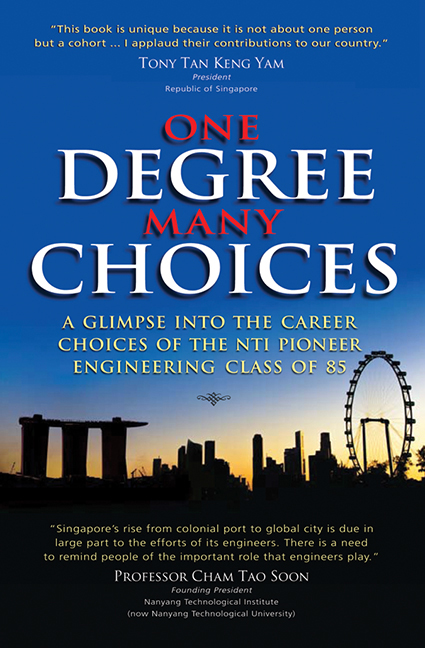 One Degree, Many Choices
One Degree, Many Choices Book contents
- Frontmatter
- Contents
- WHAT THIS BOOK IS ABOUT
- FOREWORD
- ACKNOWLEDGEMENTS
- INTRODUCTION It's All About Life Choices
- PART I THE BEGINING
- PART II ENGINEERING PURSUITS
- CHAPTER 4 Riding High on Semiconductors
- CHAPTER 5 Thriving in the Chemical Industry
- CHAPTER 6 Navigating the Marine Industry
- CHAPTER 7 Rise & Decline of the Disk Drive Industry
- CHAPTER 8 Boom & Bust in the Electronics Industry
- CHAPTER 9 Leading Lights in the IT Industry
- CHAPTER 10 Riding the Ups & Downs in the Telecommunications Industry
- CHAPTER 11 Transporting the Masses
- CHAPTER 12 Providing Electricity & Gas to Singaporeans
- CHAPTER 13 Environment Engineering & Inventions
- CHAPTER 14 Building Infrastructure & Housing Millions
- CHAPTER 15 Building Jewels In & Out of Singapore
- CHAPTER 16 Soaring in Aerospace
- CHAPTER 17 Banking on the Emerging Life Sciences Industry
- CHAPTER 18 Making Waves in Other Industries
- CHAPTER 19 Growing Singapore Inc through Government-Linked Companies
- CHAPTER 20 Defending Our Nation
- CHAPTER 21 Moulding Future Leaders
- CHAPTER 22 Training Engineers at the Frontline
- CHAPTER 23 The CSE Entrepreneurs
- CHAPTER 24 Technopreneurs from EEE
- CHAPTER 25 MPE Graduates Who Became Their Own Boss
- PART III THE LADY ENGINEERS
- PART IV NON-ENGINEERING PURSUITS
- PART V EPILOGUE
- APPENDICES
- THE SUPPORT TEAM
CHAPTER 8 - Boom & Bust in the Electronics Industry
from PART II - ENGINEERING PURSUITS
Published online by Cambridge University Press: 21 October 2015
- Frontmatter
- Contents
- WHAT THIS BOOK IS ABOUT
- FOREWORD
- ACKNOWLEDGEMENTS
- INTRODUCTION It's All About Life Choices
- PART I THE BEGINING
- PART II ENGINEERING PURSUITS
- CHAPTER 4 Riding High on Semiconductors
- CHAPTER 5 Thriving in the Chemical Industry
- CHAPTER 6 Navigating the Marine Industry
- CHAPTER 7 Rise & Decline of the Disk Drive Industry
- CHAPTER 8 Boom & Bust in the Electronics Industry
- CHAPTER 9 Leading Lights in the IT Industry
- CHAPTER 10 Riding the Ups & Downs in the Telecommunications Industry
- CHAPTER 11 Transporting the Masses
- CHAPTER 12 Providing Electricity & Gas to Singaporeans
- CHAPTER 13 Environment Engineering & Inventions
- CHAPTER 14 Building Infrastructure & Housing Millions
- CHAPTER 15 Building Jewels In & Out of Singapore
- CHAPTER 16 Soaring in Aerospace
- CHAPTER 17 Banking on the Emerging Life Sciences Industry
- CHAPTER 18 Making Waves in Other Industries
- CHAPTER 19 Growing Singapore Inc through Government-Linked Companies
- CHAPTER 20 Defending Our Nation
- CHAPTER 21 Moulding Future Leaders
- CHAPTER 22 Training Engineers at the Frontline
- CHAPTER 23 The CSE Entrepreneurs
- CHAPTER 24 Technopreneurs from EEE
- CHAPTER 25 MPE Graduates Who Became Their Own Boss
- PART III THE LADY ENGINEERS
- PART IV NON-ENGINEERING PURSUITS
- PART V EPILOGUE
- APPENDICES
- THE SUPPORT TEAM
Summary
“I also built the one millionth iMac that was presented to CEO Steve Jobs.”
— Goh Chye Lee, MPE PioneerTHE iPOD, iPHONE AND iPAD have endeared a new generation to Apple, one of the largest technology firm in the world with an annual revenue of over $84 billion in 2010. In its 35-year history, Apple has many milestones and MPE pioneer Goh Chye Lee was involved on two occasions. He shared, “I was the engineer who transferred the manufacturing of the original Macintosh –– a nine-inch monochrome all-in-one computer –– from the United States to Singapore. I also built the one millionth iMac that was presented to CEO Steve Jobs.”
Chye Lee is a case-in-point on the quality of NTI pioneers. Singapore was mired in recession in 1985 and thousands were vying for a job with Apple Computer (as the company was known then). He got an interview because he used an Apple II compatible computer and a dot-matrix printer to print his resume. He beat 103 applicants to land the manufacturing engineer job, the first fresh graduate that Apple hired. Later, other NTI pioneers such as Yew Wee Chong and Charles Yap Kiat Hoong joined him. Charles Yap spent 18 years with Apple being extensively involved with the iMac, iBook and MacBook. In recent years, Charles has been the technical product manager for Apple peripherals such as keyboard, mouse, and the popular iPad.
These pioneers are among hundreds of NTI pioneers that contributed to Singapore's electronics industry, a key economic engine over four decades. There are three pillars to this industry –– consumer electronics, semiconductors and disk drives. Apple is one of several firms driving the consumer electronics industry in Singapore. Others included Hewlett Packard (HP), Dell, Philips, Matsushita, Creative Technology and Motorola. Together they churned out microphones, loudspeakers, amplifiers, personal computers (PCs), colour TV sets, radios and videocassette recorders. The electronics industry started in the late 1960s when foreign companies set up assembly plants for products such as transistors and low-end consumer electronics. Even in the early days, the electronics industry provided jobs for one-third of the workforce.
By the mid-1990s, electronics was contributing over half the economy's manufacturing output. By 2003, the electronics industry accounted for 43 per cent of domestic exports.
- Type
- Chapter
- Information
- One Degree, Many ChoicesA Glimpse into the Career Choices of the NTI Pioneer Engineering Class of 85, pp. 38 - 43Publisher: ISEAS–Yusof Ishak InstitutePrint publication year: 2012
